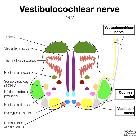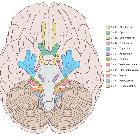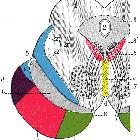vestibulocochlear nerve (CN VIII)














The vestibulocochlear nerve (CN VIII) is the eighth cranial nerve and has two roles:
- innervation to the cochlea for hearing
- innervation to the vestibule for acceleration and balance senses
Gross anatomy
Nuclei
There are two special sensory cochlear nuclei and four special sensory vestibular nuclei located within the lower pons and upper medulla.
Vestibulocochlear nerve
It emerges between the pons and the medulla, lateral to the facial nerve and nervus intermedius, passing laterally through the cerebellopontine angle to the internal acoustic meatus (IAM) with the aforementioned two other nerves.
In the IAM the nerve splits into four bundles: cochlear nerve, superior and inferior division of the vestibular nerve and nerve from the posterior semicircular canal, separated from each other by the falciform crest and Bill bar.
Cochlear nerve
The cochlear nerve relays with the first-order sensory cells in the spiral ganglion, which is in the base of the spiral lamina.
Vestibular nerve
The vestibular nerve relays in the vestibular ganglion (a.k.a. ganglion of Scarpa), from there three bundles emerge:
Related pathology
Siehe auch:
und weiter:
- Tumor Kleinhirnbrückenwinkel
- Cochlea
- Nervus abducens
- zerebellopontines Lipom (Lipom im Kleinhirnbrueckenwinkel)
- internal auditory canal nerves (mnemonic)
- vertebrobasiläre Dolichoektasie
- Felsenbein-Querfrakturen
- Bogengangtumor
- Nervus cochlearis
- facial and vestibulocochlear nerves: normal MRI appearance
- Nuclei vestibulares

 Assoziationen und Differentialdiagnosen zu Nervus vestibulocochlearis:
Assoziationen und Differentialdiagnosen zu Nervus vestibulocochlearis:


